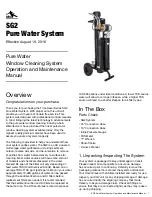
5
BEFORE YOU START
We recommend that you read the entire instructions before commencing the actual installation.
While we strongly recommend that a water treatment technician or licensed plumber perform
all installation work, a mechanically-inclined homeowner can install this system. In all cases, it
is critical that the installation be done in accordance with these instructions and all applicable
plumbing and electrical codes. Be sure to obtain all required permits. If these instructions and
the applicable codes are in conflict, the relevant plumbing/electrical code should be followed.
Equipment failure, personal injury, and/or property damage can result if this equipment is not
installed properly or if it used incorrectly.
Before you start, you need to know what system configuration you are using and confirm that
you have received all of the necessary parts.
These instructions are intended for installation of a single Ul UP-12
Ultrafiltration system WITH Wellmate WM-9 Back Flush Pressure Tank, AND one
of our optional Quick Installation Kits (UP-INST-BF or UP-INST-BF/FF). If you are
not using one our Quick Installation Kits AND the WellMate WM-9 Back Flush
Pressure Tank, this is NOT the correct installation manual for your installation.
Contact your dealer to obtain the correct manual.
Back Flush
Where a single system is used on its own, a Back Flush Pressure Tank with a minimum capacity of
about 30 gallons is required (minimum drawdown of 10 gallons) so that the system can
automatically backwash the membrane on a daily basis using treated water. This keeps the
membrane clean and prevents clogging. The
Wellmate WM-9
pressure tank is required when you
use one of our optional Quick Installation Kits. The pressure tank also provides service water
during the Back Flush process. The Back Flush process is controlled by a solenoid valve and will
require about 10 gallons of water. It is important to ensure that this volume of water plus any
service flow that can happen simultaneously are within the drawdown capacity of the selected
pressure tank. In most cases, the Back Flush is scheduled to occur in the middle of the night when
service demands should be zero. Where multiple systems are plumbed in parallel to achieve
higher flow rates, the supply of treated water for the back flush cycle can be provided by the other
unit(s) so a Back Flush Pressure Tank is not required.






































